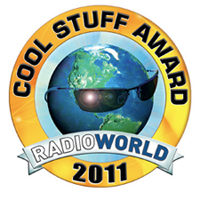You’ll find winners of Radio World’s prestigious “Cool Stuff” Awards throughout the June 1 issue of Radio World and featured here on our website. They were selected by a panel of anonymous, experienced radio engineers as notable for their design, features, cost efficiency and performance in serving broadcast users.

One winner that I want to explain in a little more detail is the Transmitter Efficiency Calculator.
This online tool was developed by the engineering consulting firm Cavell, Mertz & Associates, and was funded and introduced by FASTROAD, the technology advocacy program at NAB.
The calculator lets you predict approximate transmitter system energy costs. You answer a series of questions relating to your transmitter configuration, geographical location, the building structure in which the equipment is housed and on-site cooling capabilities to come up with an approximation of system efficiency.
What a great idea. The developers note that the purchase of a transmitter is among the most important tech decisions you can make, particularly given escalating energy costs and improvements in high-efficiency amplifier designs.
“In some cases,” the website notes, “the purchase of an energy-efficient transmitter may even pay for itself over time, particularly if care is taken to design as energy-efficient a transmission system as possible.”
The calculator lets you plug in the measured efficiency of your current transmitter, if you have it, or the efficiency specs from the manufacturer or the published efficiencies of planned new transmitters. The calculator then spits out estimated power consumption and cost estimates in dollars. The tool also can predict overall efficiency of typical installation configurations with consideration given to your local climate, energy costs, HVAC and other factors.
Results from the calculator — which grew out of a Cavell, Mertz & Associates white paper about power-efficient broadcast facility transmission design — are influenced by several assumptions the developers had to make. But NAB engineers say its outcomes should allow you to perform “what if” comparisons when considering various transmitters and scenarios.
Caveat calculator
I thought it was nifty. I asked two transmitter manufacturing veterans for comment about the idea of an online efficiency calculator. I found them supportive, if cautious.
Geoff Mendenhall, vice president of transmission research and technology at Harris Broadcast, told me he thinks the efficiency calculator is “a great idea” and said Harris provided data for the project.
But he emphasized that measurement methods behind such tools need to be “standardized, repeatable and highly accurate.” He told me that in an early look at the website, he saw some results he just didn’t believe.
“I saw one bar for over 80 percent on an FM analog transmitter. That’s not possible unless they have Kryptonite,” given that a reasonable top power amplifier efficiency is 85 percent, a number that would come down significantly once exciter, cooling system and other factors are added in.
Mendenhall also gave a general thumbs up to the efficiency white paper, calling it a good document. (That paper included a primer on power-efficient transmission design. You can read it at www.nabfastroad.org.)
I asked Cindy Hutter Cavell about Geoff’s remarks. “We concur with Geoff in his assertion that only Kryptonite-driven FM analog transmitters are capable of 80 percent overall efficiency,” she e-mailed back. “However, in the instances where manufacturers were not comfortable with providing data directly to us or were unresponsive, our only option was to access published spec sheets. We wanted both the white paper and the tool to be as complete as possible.
“We know that transmitter manufacturers all calculate their efficiency differently (which we noted in the white paper). As a result, when we asked the various manufacturers for data, we specifically requested that they give us efficiency numbers that represent the AC to RF efficiency of the transmitter.”

She said the company suspects that some of the published material presents efficiency data in terms of PA efficiency, but the available literature wasn’t always clear and the manufacturers declined to verify in some cases. “We chose to include the published data in the study so that we had as much data as possible. We welcomed (and continue to welcome) comments and feedback from all of the manufacturers.” She added that Mendenhall’s own feedback about the project was particularly helpful.
Compare carefully
Dan Dickey, president of Continental Electronics Corp., said he welcomes any effort to improve station efficiency. The topic is again on the minds of many engineers and owners now that HD Radio has come into play.
“The linearity and spectral efficiency requirements of HD Radio coupled with the broadcast transmitter marketplace, which is largely driven by initial purchase cost, has created a situation where FM HD Radio does not enjoy a comfortable efficiency margin.”
Dickey told me any industry-sponsored program for ranking efficiency must take care to compare the most efficient solution possible with each transmitter in question.
“It is not enough to just say transmitter X is more efficient than transmitter Y. We must look at the overall power consumption required to achieve a certain ERP or coverage area. Only then can comparisons be made on an equal basis amongst the various solutions to arrive at what will be the most efficient configuration for a given application. This is not so simple a task as it might first appear.”
In FM HD Radio, he continued, the efficiency of a given transmitter often bears little correlation to the total power consumption needed to deliver the right ERP. Many other factors affect the result such as building cooling, antenna type, transmission line and tower height.
Dickey suspects all transmitter manufacturers are willing to provide customers with power consumption information for a given application. But, he continued, “I must admit that I am skeptical whether anyone other than the designer of the RF plant is in a position to determine the highest efficiency solution for any given situation.”
He suspects that for most radio stations, the most important factor is total cost of ownership. “To get the lowest cost of ownership requires a skilled engineer, armed with all the necessary information, evaluating many different designs to arrive at what will work best in each situation. We would all like this process to be simple. Unfortunately I don’t think we have arrived at a point where designing an HD Radio station is as easy as some might wish.”
Dickey said designing an FM HD radio station need not be all that difficult but it can be tedious, especially if key information about each element is not readily available. “I think it would be a great help to station designers if something more could be done about that. It is my hope that this industry effort will succeed in that endeavor.”
Cool idea
It seems safe to say that a web page can’t replace a competent engineer — and I imagine the developers of this new tool would agree heartily. Indeed they stressed on the site that while the calculator’s results are believed to be reasonable, “far more accurate results can be achieved by conducting an exhaustive energy audit.”
With that caveat, I think this tool is another example of clever work being supported by the FASTROAD program. Anything that helps you become a better equipment buyer and facility designer is a good thing; anything that helps you save money is, too. Our “Cool Stuff” judges thought so, as well, and continued their tradition of honoring innovative ideas that present themselves outside of traditional product introductions.
Plus, the calculator is fun. Sit with it for a while and try plugging in variables, to see what I mean.
Try it at www.nabfastroad.org, and let me know your thoughts by e-mailing [email protected]. You can also comment directly to NAB by writing David Layer at [email protected].











